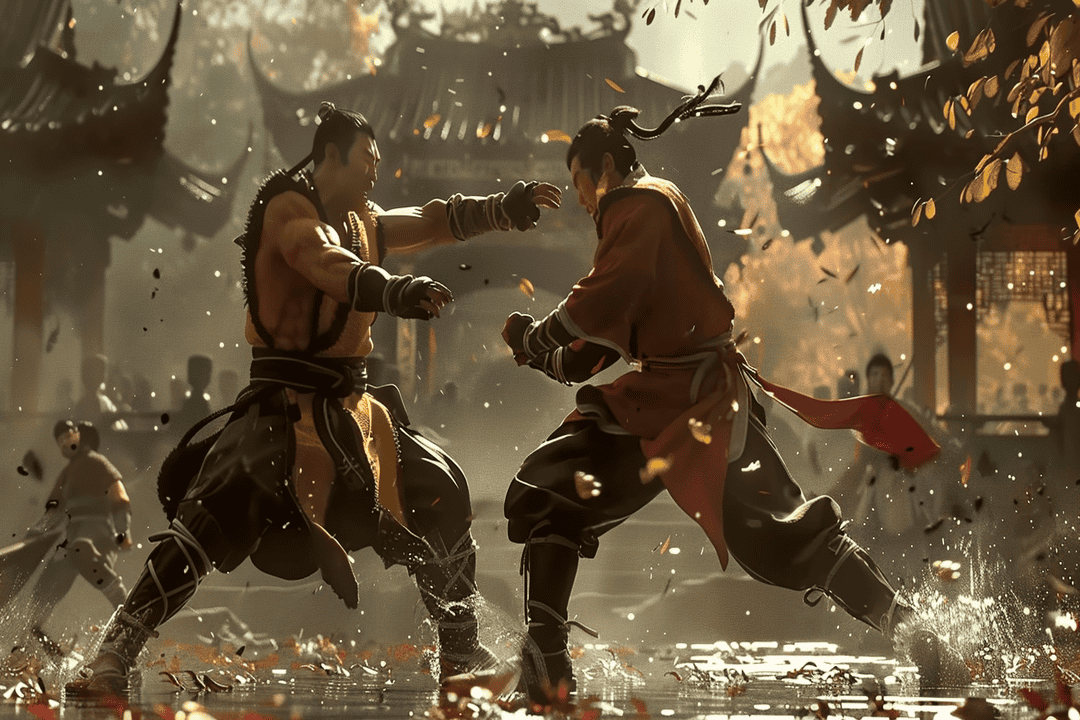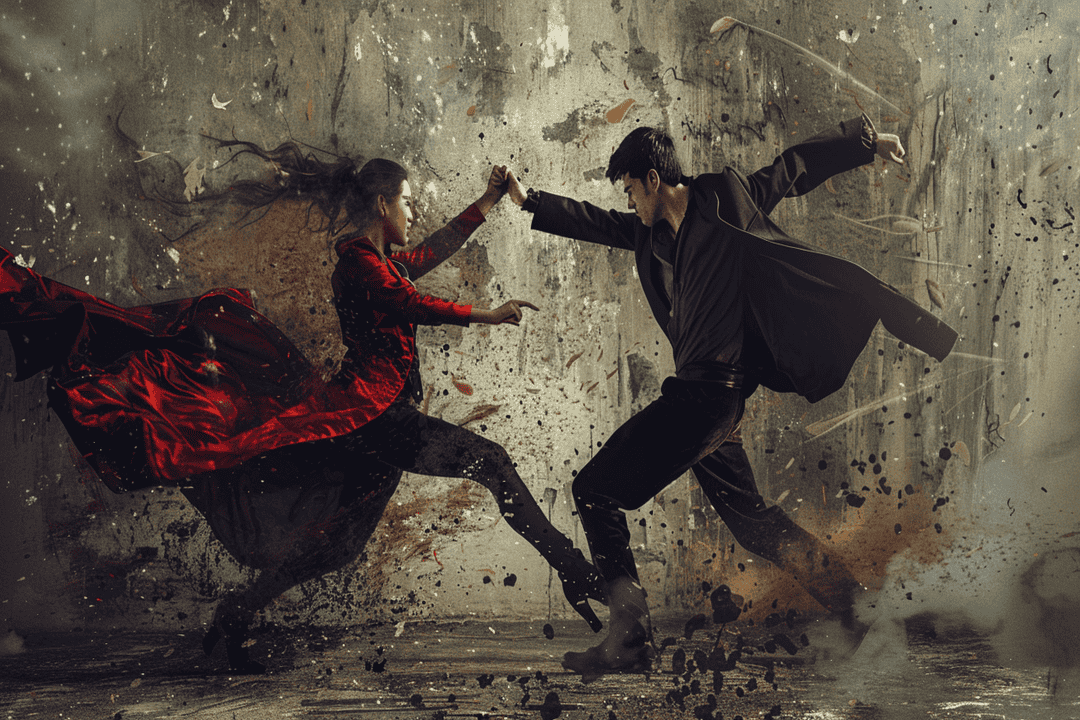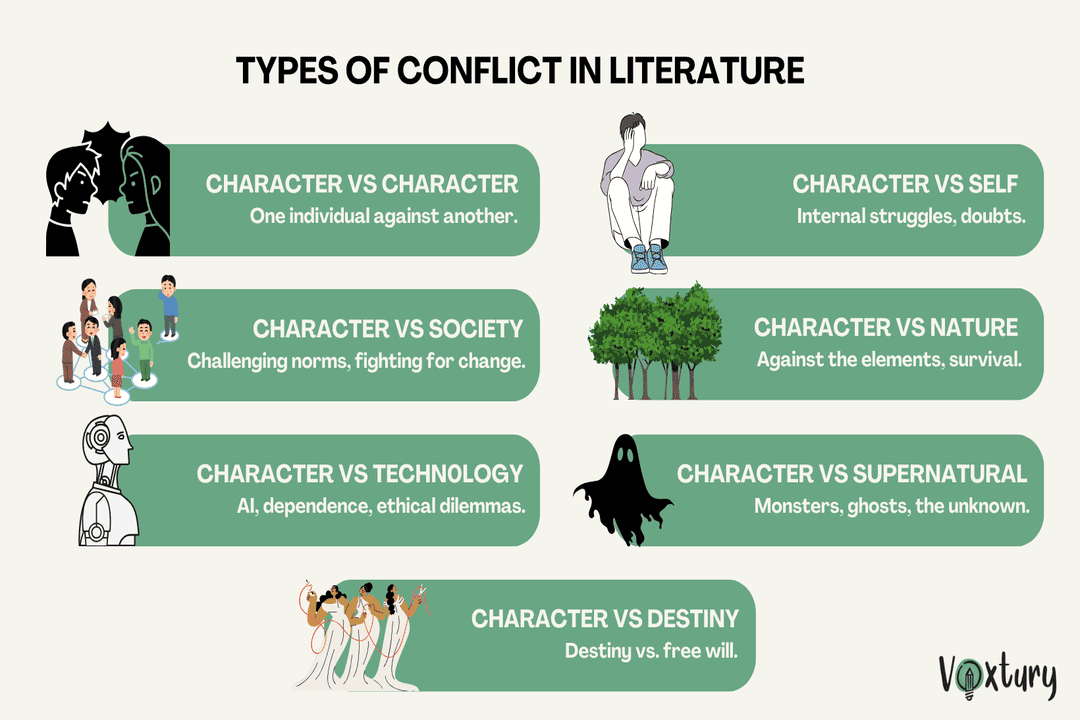Conflict is a very common way for authors to move their story forward. Although we typically associate conflict with a disagreement between two people, this is just part of the concept of conflict in literature. There are several types of conflict available to authors, and we’ll go through them in this article.
Internal vs External Conflicts – What Is the Difference?
Let’s start by understanding what conflict is in literature. In a nutshell, it is a situation where two opposing forces meet, and it typically involves the protagonist dealing with either an external force (also known as an external conflict) or an internal one (also known as internal conflict and involves a disagreement between the main character and their inner thoughts).
Types of Conflict in a Story
Now that you know the basics, we can move on to specific types of conflict in literature.
Character vs Self
This is the internal conflict we mentioned early – in this case, the main protagonist has to fight themselves, or more so their thoughts and feelings. This is typically used to showcase struggle between what is right or wrong, or between what is expected of the main character and what they actually want.
An example of that could include a character struggling to pick between two love interests – one that they are expected to be with due to societal expectations and another one that they truly love. In another scenario, a character-vs-self conflict can include the main protagonist being expected to follow with an action that they know it’s not right, for example due to pressure from those higher than them.
This type of conflict allows the reader to get to know the protagonist better, and have an insight into their character development.
Character vs Character

A pretty self-explanatory type of conflict, the person-vs-person conflict, as it is also known, involves another character or characters obstructing the protagonist’s road to reaching a goal. The result of this conflict can be a verbal or physical confrontation.
An example of that in a contemporary setting could be two people – our main character and another person – fighting for the same position at a company but the other character continues to sabotage our protagonist. In a more historical setting, it could involve a group of rebels preventing the royal (the main character) from taking over the throne.
With this type of conflict included in their work, authors explore themes such as good vs bad, revenge, justice and the complexity of human relationships.
Character vs Society
In this type of conflict, the main character is typically shown as fighting against injustices in society or a societal tradition.
A good example of this would be a story where two characters want to be together but can’t due to societal conditions (think Romeo and Juliet and the conflict between Montagues and Capulets).
By using character vs society type of conflict, the author can explore themes such as individual freedom, social change and struggle for acceptance.
Character vs Nature
When it comes to the character vs nature conflict type, the protagonist is usually faced with an unfavorable element of nature on an animal.
A common example of this would be a ship captain or a sailor facing a storm, or any story that has a natural disaster, such as an earthquake or a hurricane as the background. Another common use is a main character fighting a wild animal, e.g. a lion or a shark.
With this type of conflict, the author explores human’s ability to endure hardship, as well as themes of survival and resilience.
Character vs Technology
In this type of literary conflict, the protagonist has to deal with technology – they might be either fighting it directly (e.g. a robot) or dealing with the negative consequences it has brought into the world they live in.
A good example of this conflict type is a story where a robot gains consciousness, and their mission is to destroy humankind so the protagonist has to fight the machines. Another scenario that involves a character vs technology conflict is when the main character is addicted to it.
This type of conflict allows the author to explore themes such as technological dependance, impact of technology on human connection and the potential dangers of AI.
Character vs Supernatural Being

If an author decides to go for a character vs supernatural being kind of conflict, it means that the story involves the main character dealing with a force beyond human comprehension, such as a ghost, a vampire, a werewolf, or other kind of monster or mythical creature. This is a very common theme in fantasy novels and horror stories.
With this type of conflict, the author adds an element of extraordinary into their work. The themes that they explore with it include fear, the unknown, and the boundaries between the supernatural and reality.
Character vs Destiny or Fate
With this type of conflict, the author explores the idea of free will and destiny—the protagonist has to fight against what he’s been destined to do. Good examples of this are stories with characters who have a predetermined faith, such as a prophecy or a curse, and who need to decide whether to defy it or accept it.
By using this type of conflict in their story, the author can dive into themes such as predestination, free will, and the search for meaning in a seemingly chaotic universe.
Types of Conflicts in Literature – An Overview

Tips for Writing Conflicts in Literature
Crafting the perfect conflict for your literary work might not be the easiest, but it’s not impossible, especially with our expert tips:
- Determine what kind of conflict will be best for your stories. While there is no rule that prevents you from using one or another conflict type, there are some that will work better than others based on genre. For example, a fantasy novel might benefit from character vs destiny or character vs supernatural conflicts, while for thriller novels, character vs character conflict works really well.
- Raise the stakes gradually. Introducing the conflict from the very beginning might end up in your reader becoming disinterested as the story progresses, so try to start small and introduce challenges as your book goes on. A good technique to use here is foreshadowing, which involves hinting at what’s about to happen.
- Be clear about the stakes. Be very clear about what your character stands to lose if they fail to overcome the challenge they’re presented with – is it their reputation? Their love interest? Their freedom? Also, present your reader with the worst possible outcome, as that builds tension and might increase their interest in the resolution of the conflict.
- Show, don’t tell. Rather than telling your readers in a straightforward way that there’s a conflict and what (or who) it involves, try to express it in different ways, for example, through vivid descriptions, sensory details, and the emotional and physical impact it has on your characters. Don’t forget about body language – fastened heartbeat, quickened breathing and tension all over the character’s body are good examples of how to represent it.
The Bottom Line
Adding a conflict into your literary work, whether it’s between two characters, a character and their inner thoughts or a protagonist and external forces, can be a great way of moving your story forward and triggering character development. You also don’t have to limit yourself to just one type of conflict – it’s your story, so don’t hesitate to explore different ones and see which one(s) work best for it.
While story writing is a complex process, it doesn’t have to be. With Voxtury’s book writing section, you can learn all there is about how to write a novel, starting from story structure and ending on today’s topic. We also have a book publishing section for when you’re ready to pull the trigger on the process.
Although before that, you might want to take advantage of our online editor – with it, things like repetitions or typos will become a thing of the past.